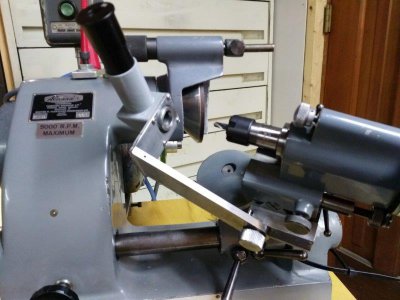- Joined
- Feb 9, 2017
- Messages
- 5,255
good job LarryS$. My clamps all worked properly but the flute grinding attachment housing on mine was like .015 sloppy, not a slip fit like it should have been. So I bored and sleeved it. What a cluster that was! The casting had some super hard spots in it so I had to buy carbide tools to get er done. Now its a nice slip fit and I’ve not done another flute. What I’d done was I needed a 5/16 endmill and didn’t have one, but I had a metric one so I ground the flutes down to size even with the head being sloppy. Having the room to do so many cuts to get to size gave me practice and ended up getting it right for the finishing cut. I highly recommend using old dull mills to practice on. My old mill/drill came with a bunch of dull and messed up ones so I didn’t care if they ended up usable or not. That really helps. My brother had a bucket full of dead endmills I shoulda grabbed.
Another mod this could use is either a tiny roller or the probe to rotate that you hold the flute against when doing flutes. Not running any other tool grinders I don’t know if other setups have that, but why not? That would make it so much smoother instead of pulling against a static probe.
I didn’t know about the Shars version and went down the eBay rabbit hole bait and switch. I didn’t know anything but the little Deckel collets were available but found somebody who equipped them with R8. So that’s the route I went. With the Shars they went 5c, way superior for this application because of the ability to go through the collet. So I would think you’d not run out of x axis like I do with R8. I have learned to adapt, but not the wiz like Pontiac428. I did remove the 0 stops in the head to be able to do negative angles. I also want to make a dedicated dust collection head for it because it throws grinding dust everywhere!
Another mod this could use is either a tiny roller or the probe to rotate that you hold the flute against when doing flutes. Not running any other tool grinders I don’t know if other setups have that, but why not? That would make it so much smoother instead of pulling against a static probe.
I didn’t know about the Shars version and went down the eBay rabbit hole bait and switch. I didn’t know anything but the little Deckel collets were available but found somebody who equipped them with R8. So that’s the route I went. With the Shars they went 5c, way superior for this application because of the ability to go through the collet. So I would think you’d not run out of x axis like I do with R8. I have learned to adapt, but not the wiz like Pontiac428. I did remove the 0 stops in the head to be able to do negative angles. I also want to make a dedicated dust collection head for it because it throws grinding dust everywhere!
Last edited:


